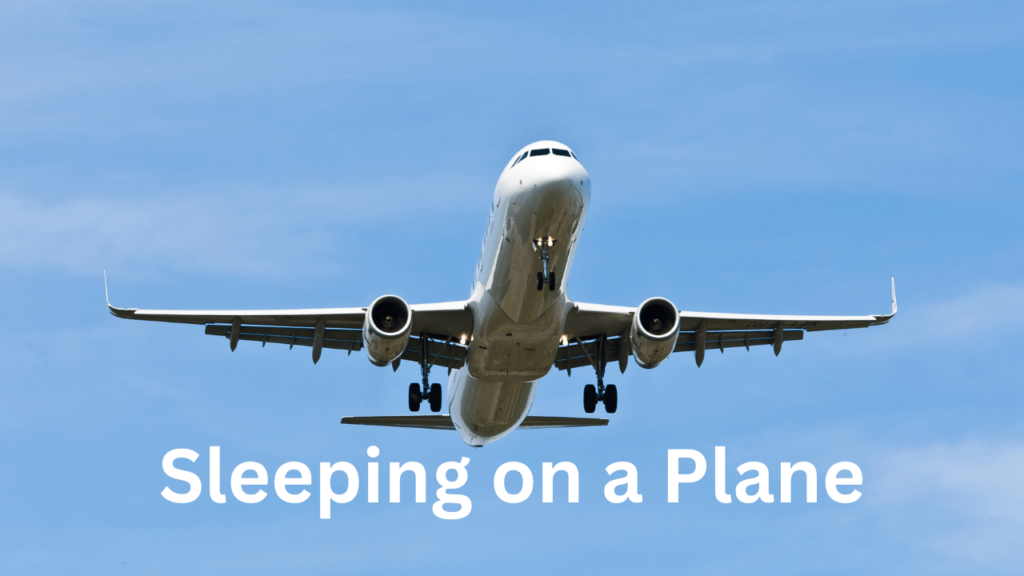Air travel has become an essential part of modern life, connecting people across continents in just a matter of hours. But anyone who has taken a long-haul flight knows how exhausting it can be—especially if you struggle to sleep on a plane. Whether you’re heading on a business trip and need to land refreshed, or flying to start a much-anticipated holiday, sleeping well on board can make all the difference.
In this article, I’ll share a detailed, research-backed, and personally informed guide to sleeping on a plane. I’ll cover the science of sleep in the air, practical tips for travelers, expert insights, and my own experiences of what works—and what doesn’t. By the end, you’ll have a set of actionable strategies to help you rest better on your next journey.
Why Sleeping on a Plane Matters
Flying disrupts almost every part of our natural rhythm. Airplane cabins are noisy, the air is dry, and seating is often cramped. Add in jet lag and time zone changes, and you’ve got a recipe for poor rest.
According to the Centers for Disease Control and Prevention (CDC), quality sleep is crucial for immune function, cognitive performance, and mood regulation. Without it, you risk feeling groggy, stressed, and less able to enjoy your trip. For frequent flyers, chronic sleep disruption can even affect long-term health.
I remember one particular overnight flight from Dublin to New York. I was so excited at first that I didn’t think much about sleep. But by the time I landed, I was groggy, irritable, and struggled to stay awake during a work meeting. That experience taught me that sleeping well on planes isn’t a luxury—it’s a necessity.
Understanding the Challenges of Sleeping on a Plane
Before diving into tips, it helps to understand why sleep is so difficult in the air:
- Seating Position
Most economy-class seats don’t recline enough to allow comfortable sleep. Being upright makes it harder for your body to relax. - Noise and Light
From engine hums to crying babies, planes are full of disturbances. Even dim cabin lighting can interfere with melatonin production—the hormone that signals your body it’s time to sleep. - Cabin Environment
Airplane cabins are pressurized at around 6,000–8,000 feet, which can lead to mild dehydration and discomfort. Dry air makes you thirsty, while lower oxygen levels may make sleep shallower. - Timing and Jet Lag
If your body clock says it’s daytime, it’s difficult to convince yourself to rest. Jet lag complicates this by shifting your internal rhythm.
Knowing these challenges means we can tackle them more effectively.
Preparing Before You Fly
Getting good sleep on a plane starts well before you board. Preparation is key.
1. Choose the Right Flight
If possible, book an overnight flight when traveling long distances. This aligns with your body’s natural sleep cycle, making it easier to rest. For short-haul flights, try to travel during the day so you don’t feel pressured to sleep.
2. Pick the Best Seat
Your seat choice makes a huge difference:
- Window seats are the best for sleeping, as you can lean against the wall and avoid being disturbed by others needing the aisle.
- Avoid seats near bathrooms or galleys, where there’s more noise and traffic.
- If budget allows, consider premium economy or business class for more legroom and recline.
Personally, I always aim for a window seat over the wing. The vibration is steadier there, and I find it easier to nod off.
3. Adjust Your Sleep Schedule in Advance
If you’re crossing multiple time zones, try gradually shifting your sleep and wake times by an hour or two before departure. Sleep experts recommend this method to minimize jet lag.
4. Pack Sleep Essentials
A small travel kit can transform your sleep quality:
- Neck pillow (memory foam works best)
- Noise-canceling headphones or earplugs
- Sleep mask to block light
- Light blanket or large scarf for warmth
- Compression socks to improve circulation
In-Flight Tips for Sleeping Well
Now, let’s get into what you can do during the flight itself.
1. Dress Comfortably
Wear loose, breathable clothing and layer up. Planes can get chilly, especially at night. Avoid tight waistbands or shoes that restrict circulation.
2. Limit Caffeine and Alcohol
While a glass of wine might make you drowsy, alcohol often disrupts sleep quality, leading to more awakenings. Similarly, caffeine stays in your system for hours and can make falling asleep harder. I personally avoid coffee for at least 6 hours before a long flight.
3. Stay Hydrated
The dry cabin air can leave you dehydrated, which worsens fatigue. Drink water regularly, but not so much that you’re constantly getting up to use the restroom. Herbal teas (if available) can also be soothing.
4. Eat Lightly
Heavy meals make you uncomfortable and can disrupt digestion. Opt for lighter, protein-rich snacks instead. Some airlines now offer healthier options—choose those when possible.
5. Create a Sleep-Friendly Space
Recline your seat as much as possible without bothering the person behind you. Use your pillow to support your neck and lower back. Put on your mask, plug in your earplugs, and signal to the crew and fellow passengers that you’re trying to sleep.
6. Use Relaxation Techniques
Breathing exercises, meditation apps, or even gentle stretches can calm your body. I often do a few minutes of deep breathing (inhale 4 counts, exhale 6 counts), which helps me drift off faster.
7. Time Your Sleep Wisely
Try to sleep according to your destination’s time zone, not your departure time. This helps reduce jet lag. For example, if you’re flying from Europe to Asia overnight, aim to sleep during the first half of the flight to mimic local night hours.
The Role of Technology and Sleep Aids
1. Noise-Canceling Headphones
Many travelers swear by them. Studies have shown that reducing environmental noise improves sleep efficiency. Personally, I’ve found them worth every penny on long flights.
2. Melatonin Supplements
Melatonin can help your body adjust to new time zones. Research indicates it’s especially effective for eastward travel. However, always consult a doctor before using supplements.
3. Sleep Medications
Some people use mild sedatives or over-the-counter sleep aids. While they can work, they also carry risks like grogginess upon waking or dependency. If you’re considering this, talk to a healthcare professional first.
4. Travel Apps
Guided meditation apps like Calm or Headspace can provide sleep-friendly soundscapes or relaxation routines.
Common Mistakes to Avoid
- Forgetting to move: Sitting still for long periods increases your risk of deep vein thrombosis (DVT). Set an alarm to stretch or walk every few hours.
- Over-reliance on alcohol: It may knock you out but will likely lead to restless, poor-quality sleep.
- Not adjusting expectations: Even with the best strategies, plane sleep won’t match your bed. Aim for restfulness rather than perfect sleep.
Frequently Asked Questions
1. Can you really get quality sleep on a plane?
Yes, though it won’t be as deep or restorative as home sleep. Studies show people in flight typically get shorter sleep cycles, but good preparation can still leave you feeling rested.
2. Is it better to sleep the entire flight or in intervals?
That depends on your destination. Long blocks of sleep are best if they align with your destination’s nighttime. For short flights, short naps may be more realistic.
3. How can tall people sleep better on planes?
Choose exit row seats, aisle seats, or upgrade if possible. Using a small footrest or inflatable cushion can also improve comfort.
4. Is business class worth it for sleep?
If sleep is a priority and your budget allows, yes. Lie-flat beds and quieter cabins make a world of difference. However, with good planning, you can still sleep decently in economy.
My Personal Experience with Sleeping on Planes
Over the years, I’ve learned that my sleep success depends on a few non-negotiables: a window seat, noise-canceling headphones, and a good neck pillow. On one flight to Toronto, I slept nearly 6 hours straight—something I never thought possible. On another flight, I forgot my sleep mask and barely got 30 minutes of rest. That contrast taught me the value of preparation.
I also realized mindset matters. If I tell myself, “I probably won’t sleep well,” I end up restless. But if I prepare and approach the flight calmly, I usually manage a few hours of rest.
Conclusion: Sleep Smarter, Travel Better
Sleeping on a plane isn’t easy, but it is possible with the right strategies. From preparing before you fly, to optimizing your in-flight routine, to using technology wisely, you can significantly improve your chances of rest.
Remember, every traveler is different. Experiment with seat choices, travel gear, and sleep techniques until you find what works best for you. Even small improvements can transform how you feel when you land.
Next time you board a flight, try applying these tips—you may find yourself waking up more refreshed and ready to enjoy your destination.
Have you found a sleep trick that always works for you on planes? I’d love to hear your thoughts and experiences.

Hi, I’m Tanvir, the founder and author of Explore Ireland Now. With a deep love for Ireland and its rich culture, history, and landscapes, I created this site to share everything that makes this beautiful country worth exploring. Whether you’re a local looking for hidden gems or a traveler planning your next adventure, I provide insightful guides, tips, and recommendations to help you experience Ireland to the fullest.
From stunning landscapes to vibrant cities and quaint villages, Ireland is full of wonders waiting to be discovered. Through my personal experiences and research, I aim to bring you the most up-to-date information and inspiration for your journey.
Thank you for visiting Explore Ireland Now—I hope my content helps you uncover all that this incredible country has to offer! If you have any questions or need travel advice, feel free to reach out.



